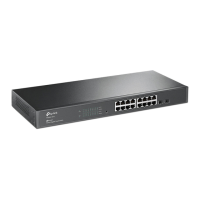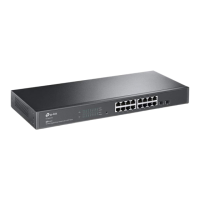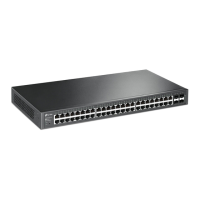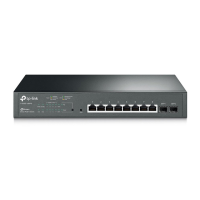
Do you have a question about the TP-Link T1600G-28TS and is the answer not in the manual?
| Switch type | Managed |
|---|---|
| Switch layer | L2+ |
| Web-based management | No |
| Quality of Service (QoS) support | Yes |
| Power connector | DC-in jack |
| SFP module slots quantity | 4 |
| Basic switching RJ-45 Ethernet ports type | Gigabit Ethernet (10/100/1000) |
| Basic switching RJ-45 Ethernet ports quantity | 24 |
| Stackable | - |
| Form factor | 1U |
| Certification | CE, FCC, RoHS |
| Product color | Black |
| Networking standards | IEEE 802.1D, IEEE 802.1p, IEEE 802.1s, IEEE 802.1w, IEEE 802.1x, IEEE 802.3ab, IEEE 802.3ad, IEEE 802.3i, IEEE 802.3u, IEEE 802.3x, IEEE 802.3z |
| DHCP features | DHCP client |
| AC input voltage | 100 - 240 V |
| AC input frequency | 50 - 60 Hz |
| Power consumption (max) | 23.2 W |
| Throughput | 41.7 Mpps |
| MAC address table | 16000 entries |
| Storage temperature (T-T) | -40 - 70 °C |
| Operating temperature (T-T) | 0 - 40 °C |
| Storage relative humidity (H-H) | 5 - 90 % |
| Operating relative humidity (H-H) | 10 - 90 % |
| Depth | 180 mm |
|---|---|
| Width | 440 mm |
| Height | 44 mm |
Details accessing the switch via web interface, covering HTTP/HTTPS servers, login process, and typical interface display.
Covers essential system tools: boot file, configuration backup/restore, firmware upgrade, rebooting, and resetting the switch.
Details configuring access control, HTTP, HTTPS, SSH, and Telnet for secure remote access to the switch.
Details configuring basic port parameters: Jumbo frames, speed, duplex, flow control, and LAG settings via GUI and CLI.
Guides on limiting MAC addresses per port, selecting learn modes, and setting port security status to prevent attacks.
Details LAG configuration steps: setting global load-balancing algorithm and configuring static LAG or LACP via GUI and CLI.
Details MAC address table configuration: adding static entries, binding dynamic entries, modifying aging time, and adding filtering entries via GUI and CLI.
Details 802.1Q VLAN configuration: PVID settings, VLAN creation, and port assignment to VLANs via GUI and CLI.
Details MAC VLAN configuration: 802.1Q VLAN setup, MAC address binding, and enabling MAC VLAN on ports via GUI and CLI.
Details Protocol VLAN configuration: 802.1Q VLAN setup, protocol template creation, and Protocol VLAN configuration via GUI and CLI.
Details STP/RSTP configurations on ports and globally: status, priority, path cost, port roles, and mode via GUI and CLI.
Guides MSTP configuration: port parameters, MSTP region setup, global MSTP configuration, and verification via GUI and CLI.
Details IGMP Snooping configuration: global settings, ports, VLANs, multicast VLANs, querier, profiles, statistics, and accounting/authentication via GUI and CLI.
Details configuring IPv4 and IPv6 parameters for Layer 3 interfaces: creation, IP assignment, and viewing details via GUI and CLI.
Details IPv4 static route configuration: adding routes, specifying destination, mask, next hop, and distance via GUI and CLI.
Guides configuring DHCP Relay, including enabling relay, Option 82, and specifying DHCP servers for interfaces or VLANs via GUI and CLI.
Details ARP configurations: viewing entries, adding/deleting static entries, configuring ARP function, and clearing ARP cache via GUI and CLI.
Details DiffServ configuration: priority modes (802.1P, DSCP, Port Priority) and schedule modes (SP, WRR, SP+WRR, Equ) via GUI and CLI.
Details Voice VLAN configuration: VLAN creation, OUI addresses, global settings, port modes, security, and LLDP-MED integration via GUI and CLI.
Details PoE power management: configuring parameters manually and using profiles for ports via GUI and CLI.
Details ACL configuration: creating ACLs (MAC, IP, IPv6), rules, policies, and binding them to ports or VLANs via GUI and CLI.
Details IP-MAC binding: manual and dynamic methods (ARP Scanning, DHCP Snooping), and viewing binding entries via GUI and CLI.
Details 802.1X configuration: RADIUS server setup, global and port configurations, and AAA integration via GUI and CLI.
Details SNMP configurations: enabling SNMP, creating views, groups, users, and communities via GUI and CLI.











